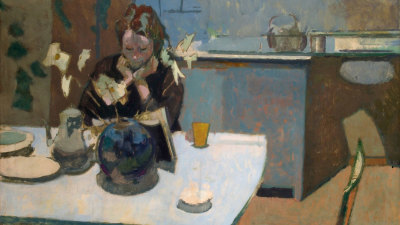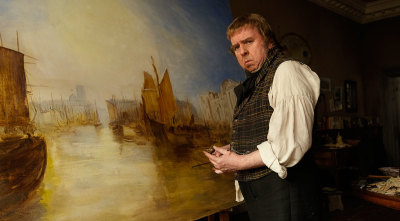10 art exhibitions to see in June
10 art exhibitions to see in June
By Alice Primrose
Published 1 June 2018
From giant hammocks to swollen balloons to cyborg limbs, zeppelins, dancers and animals – the UK’s art galleries are filled with some exciting stuff this month. Here’s what we recommend seeing.
-
OPAVIVARÁ: Utupya
Tate Liverpool
Elegantly clambering in and out of a hammock is tricky enough, but in this interactive installation by Brazilian collective OPAVIVARA!, they’re asking visitors to negotiate climbing into a huge (really huge) hammock, all at the same time, in the middle of an art gallery. If that doesn’t sound like your cup of tea, you can blend your own herbal drink and settle down for a chat at the communal tea station, or take off your clothes and cover your body with animal patterns using a paint roller. Whatever you prefer.
-

OPAVIVARÁ!: Utupya at Tate Liverpool
© Tate Liverpool, Laura Deveney
-
Eddy Kamuanga Ilunga: Fragile Responsibility
October Gallery, London
“Understanding the present through the past is central to my work”, says Congolese painter Eddy Kamuanga Ilunga. He explores the history of his country through his work, which fills canvases with pre-colonial languages, classical poses, European porcelain once traded for slaves, bright wax-print fabrics from Belgian’s imperial textile mills, and the computer motherboards made by plundering his country’s coltan mines. They are astute, unsettling and jarring – as he says, art is a way to “raise awareness about the conditions and contradictions under which people live”.
-

Eddy Kamuanga Ilunga , Fragile 7 , 2018 .
Acrylic and oil on canvas. 186cm x 197cm. Courtesy of October Gallery, London.
-
Material Environments
The Tetley, Leeds
If you find it hard to walk past an artist’s open studio without quickly peering in, or if you often find yourself standing in front of an artwork wishing you could ask the artist what on earth it’s all about, then this exhibition comes highly recommended. Five contemporary artists are each inhabiting a room of The Tetley, where they are researching, designing, testing, making and displaying work for several months. Discover giant balloons, proliferating clay sculptures, UFO investigations and maybe even a few artist-residents who can tell you what it all means.
-

Keith Harrison , Bad Shit , 2018 .
Courtesy the artist and The Tetley. Photo: Jules Lister.
-
Lee Miller and Surrealism in Britain
The Hepworth Wakefield
When 1930s political turmoil sent many of Europe’s artists over the sea to England, they brought their burgeoning Surrealist ideas to London – and the American-by-way-of-Paris photographer Lee Miller was among them. Once here, she played a central role in their growing community, which included Man Ray, Leonora Carrington, Max Ernst, Eileen Agar and René Magritte. This exhibition captures her time and creative influence in London (including a “sudden Surrealist invasion” of Cornwall), as well as tracing her ever-extraordinary life afterwards, when she returned to Europe to be a WWII correspondent for Vogue.
-

Lee Miller , David E. Scherman, dressed for war, London, England , 1942 .
© Lee Miller Archives, England 2018. All rights reserved.
-
Lee Bul: Crashing
Hayward Gallery, London
From one Lee to another. The South Korean artist has filled the newly renovated Hayward Gallery with fleshy appendages, pristine cyborgs, stray limbs, sci-fi sculptures, mutant creatures and mirror mazes. The mid-survey show is a carnival of materials, genres, influences and ideas, and like all the best carnivals it raises important questions about the rules it’s upending. Keep an eye (or a nostril) out for her installation Majestic Splendour – made of sequined rotting fish – which had to be removed when it was first shown at MoMA in 1997.
-

Installation view of Lee Bul, 'Via Negativa II', 2014 at Hayward Gallery, 2018 (interior detail)
© Lee Bul 2018. Photo: Mark Blower
-
Chantal Joffe: Personal Feeling is the Main Thing
The Lowry, Salford
The 19th-century artist Paula Modersohn-Becker is thought to be the first female artist to have painted a pregnant self-portrait and also a nude self-portrait. She forms a very fitting counterpart to this exhibition, where her work is shown alongside over 50 portraits by Chantal Joffe. As Joffe said in a recent interview with the RA, painting herself and people she knows “records one’s own journey through life; this is what I saw, my view, my history”. With works from across her career, this show is a tender, intimate journey through the lives of two artists.
-

Chantal Joffe , Poppy, Esme, Oleanna, Gracie and Kate , 2014 .
40 x 80 x 3.5 cm. © Chantal Joffe. Courtesy the artist and Victoria Miro, London / Venice.
-
Frida Kahlo: Making Her Self up
V&A, London
From the age of 18, plaster corsets were a necessary part of Frida Kahlo’s outfits, after a bus crash that left her spine unable to support itself. The artist decorated them with fabric scraps and small mirrors and painted them (often while lying in bed wearing them) with tigers, monkeys, peaches, birds, a hammer and sickle. Her corsets, long skirts, handmade jewellery, traditional Mexican shawls, favourite Revlon lipstick, personalised prosthetics and even her medicines and letters have been exhumed from the home where she lived and died and now sit in this exhibition alongside self-portraits and photographs of the artist.
-

Frida Kahlo with Olmec figurine, 1939
Photograph Nickolas Muray. © Nickolas Muray Photo Archives
-
Elizabeth Frink: Fragility and Power
Abbot Hall Art Gallery, Kendal
Sculptor and printmaker Elizabeth Frink hoped that “the more art people see, the more they stop and look and think about things”. This major exhibition is a chance to see sculptures, maquettes and works on paper from throughout her career, a quarter of a century after her death. The show also explores her various influences and inspirations as an artist who willfully and gleefully ignored 20th-century trends and commercial fashions.
-

Elizabeth Frink , Harbinger .
Courtesy of Abbot Hall Art Gallery.
-
Paul Maheke: A fire circle for a public hearing
Chisenhale Gallery, London
Paul Maheke’s newly commissioned installation occupies the entire Chisenhale Gallery, filling it with choreographed dances inspired by Bruce Nauman, Michael Jackson, Audre Lorde, Grace Jones, Judith Butler, Édouard Glissant, and the artist’s letter to an ex-boyfriend, among other things. Drawing on cosmology, astrology and speculative belief systems throughout the exhibition, the artist describes it as “a world taking shape in front of an audience… an ever shape-shifting space”.
-

Production still from Paul Maheke’s 'A Fire Circle for a Public Hearing' (work in progress) at Chisenhale Gallery, London, 2018
-
Animals & Us
Turner Contemporary, Margate
From Beatrix Potter’s beloved bunnies to the three days Joseph Beuys locked himself in a room with a wild coyote, this exhibition looks at humans’ messy and complicated relationships with our furry (sometimes) friends. Work by over 20 artists drawing on biology, evolution, technology, agriculture, anthropology and their own darling pets ask us to consider how we entangle our lives with animals, and yet keep them radically, strangely separate.
-

Mark Dion , Mobile Wilderness Unit – Wolf , 2006 .
Courtesy Turner Contemporary, Margate.













